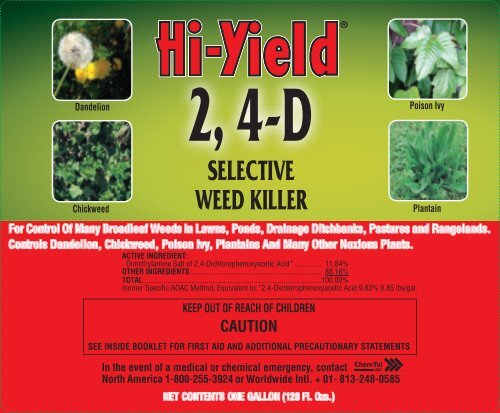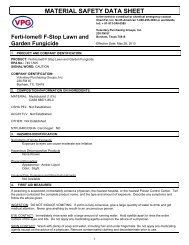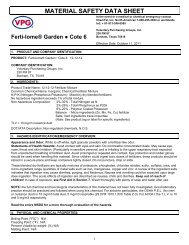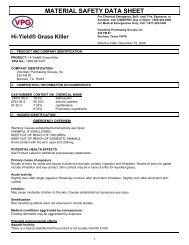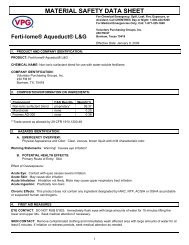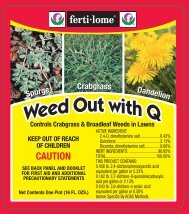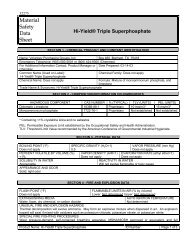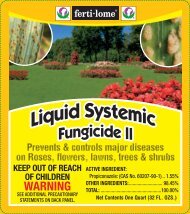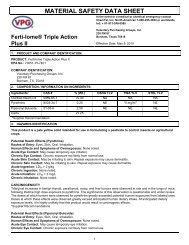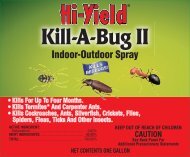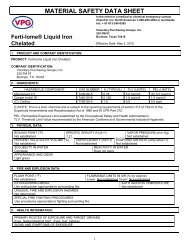Label 21416 2 4-D Selective Weed Killer Approved 03 ... - Fertilome
Label 21416 2 4-D Selective Weed Killer Approved 03 ... - Fertilome
Label 21416 2 4-D Selective Weed Killer Approved 03 ... - Fertilome
Create successful ePaper yourself
Turn your PDF publications into a flip-book with our unique Google optimized e-Paper software.
DandelionChickweed2, 4-DSELECTIVEWEED KILLERFor Control Of Many Broadleaf <strong>Weed</strong>s In Lawns, Ponds, Drainage Ditchbanks, Pastures and Rangelands.Controls Dandelion, Chickweed, Poison Ivy, Plantains And Many Other Noxious Plants.ACTIVE INGREDIENT:Dimethylamine Salt of 2,4-Dichlorophenoxyacetic Acid* .............. 11.84%OTHER INGREDIENTS:..................................................................... 88.16%TOTAL:..............................................................................................100.00%Isomer Specific AOAC Method, Equivalent to:*2,4-Dichlorophenoxyacetic Acid 9.83% 0.85 lbs/gal.KEEP OUT OF REACH OF CHILDRENCAUTIONSEE INSIDE BOOKLET FOR FIRST AID AND ADDITIONAL PRECAUTIONARY STATEMENTSIn the event of a medical or chemical emergency, contactNorth America 1-800-255-3924 or Worldwide Intl. + 01- 813-248-0585NET CONTENTS ONE GALLON (128 Fl. Ozs.)Poison IvyPlantain<strong>21416</strong>_HY_2_4_D_SG_Front.indd 19/6/11 7:11 AM
Hi-Yield 2,4-D <strong>Selective</strong> <strong>Weed</strong> <strong>Killer</strong>IF In EYESIFSWaLLoWEDIF on SKInoRCLoThInGFIRST aID• Hold eye open and rinse slowly and gently withwater for 15 to 20 minutes.• Remove contact lenses, if present, after the first5 minutes, then continue rinsing eye.• Call a poison control center or doctor fortreatment advice.• Call poison control center or doctor immediatelyfor treatment advice.• Have person sip a glass of water if able to swallow.• Do not induce vomiting unless told to do so bythe poison control center or doctor.• Do not give anything by mouth to an unconsciousperson.• Take off contaminated clothing.• Rinse skin immediately with plenty of waterfor 15 to 20 minutes.• Call a poison control center or doctor fortreatment advice.hoT LInE nUMBERHave the product container or label with you when calling a poisoncontrol center or doctor, or going for treatment.In the event of a medical or chemical emergency, contactnorth america 1-800-255-3924 or Worldwide Intl. + 01- 813-248-0585PEEL FROM CORNER OF BOOKLET10M-6-<strong>03</strong>12Manufactured By:230 FM 87BonhaM, TX 75418EPa Reg. no. 228-238-7401EPa Est. no. 7401-TX-01Visit Us at: www.hi-yield.com*32221-CBEBGd
PRECAUTIONARY STATEMENTSHAZARDS TO HUMANS AND DOMESTIC ANIMALSCAUTION - PRECAUCIONHarmful if swallowed. Causes moderate eye irritation. Avoid contactwith eyes, skin or clothing.PERSONAL PROTECTIVE EQUIPMENT (PPE)Some materials that are chemical-resistant to this product aremade of any waterproof material. If you want more options, followthe instructions for category A on an EPA chemical-resistancecategory selection chart.All mixers, loaders, applicators, flaggers, and other handlersmust wear:• long-sleeved shirt and long pants,• shoes and socks,• chemical-resistant gloves,• Chemical-resistant apron when mixing or loading, cleaning upspills or equipment, or otherwise exposed to the concentrate.See engineering controls for additional requirements.Follow manufacturer’s instructions for cleaning/maintaining PPE. Ifno such instructions for washables exist, use detergent and hotwater. Keep and wash PPE separately from other laundry.Engineering Control Statements:When handlers use closed systems or enclosed cabs in a mannerthat meets the requirements listed in the Worker Protection Standard(WPS) for agricultural pesticides [40 CFR 170.240(d) (4-6)],the handler PPE (personal protective equipment) requirements maybe reduced or modified as specified in the WPS.1
USER SAFETY RECOMMENDATIONSUsers Should:• Wash hands before eating, drinking, chewing gum, using tobaccoor using the toilet.• Remove clothing/PPE immediately if pesticide gets inside.Then wash thoroughly and put on clean clothing. If pesticidegets on skin, wash immediately with soap and water.• Remove PPE immediately after handling this product. Wash theoutside of gloves before removing. As soon as possible, washthoroughly and change into clean clothing.ENVIRONMENTAL HAZARDSFor Terrestial Uses:This pesticide may be toxic to fish and aquatic invertebrates. Donot apply directly to water, to areas where surface water is present,or to intertidal areas below the mean high water mark. Drift andrunoff may be hazardous to aquatic organisms in water adjacent totreated areas. Do not contaminate water when disposing of equipmentwash waters or rinsate.This chemical has properties and characteristics associated withchemicals detected in groundwater. The use of this chemical in areaswhere soils are permeable, particularly where the water tableis shallow, may result in groundwater contamination. Applicationaround a cistern or well may result in contamination of drinkingwater or groundwater.For Aquatic Uses:Fish breathe dissolved oxygen in the water and decaying weeds alsouse oxygen. When treating continuous, dense weed masses, it may beappropriate to treat only part of the infestation at a time. For example,apply the product in lanes separated by untreated strips that can betreated after vegetation in treated lanes has disintegrated. During thegrowing season, weeds decompose in a 2 to 3 week period followingtreatment. Begin treatment along the shore and proceed outwards in2
ands to allow fish to move into untreated areas. Waters having limitedand less dense weed infestations may not require partial treatments.DIRECTIONS FOR USEIt is a violation of Federal law to use this product in a manner inconsistentwith its labeling.READ ENTIRE LABEL BEFORE USING THIS PRODUCT. USESTRICTLY IN ACCORDANCE WITH LABEL PRECAUTIONARYSTATEMENTS AND DIRECTIONS.Do not apply this product in a way that will contact workers or otherpersons, either directly or through drift. Only protected handlers maybe in the area during application. For any requirements specific to yourState or Tribe, consult the agency responsible for pesticide regulation.AGRICULTURAL USE REQUIREMENTSUse this product only in accordance with its labeling and with theWorker Protection Standard, 40 CFR part 170. This Standard containsrequirements for the protection of agricultural workers onfarms, forests, nurseries, and greenhouses, and handlers of agriculturalpesticides. It contains requirements for training, decontamination,notification, and emergency assistance. It also contains specificinstructions and exceptions pertaining to the statements on this labelabout personal protective equipment (PPE) and restricted-entry interval.The requirements in this box only apply to uses of this productthat are covered by the Worker Protection Standard.Do not enter or allow worker entry into treated areas during therestricted-entry interval (REI) of 48 hours.PPE required for early entry to treated areas that is permittedunder the Worker Protection Standard and that involves contactwith anything that has been treated, such as plants, soil, or wateris: coveralls, chemical-resistant gloves made of any waterproofmaterial, shoes plus socks and protective eyewear.3
NON-AGRICULTURAL USE REQUIREMENTSThe requirements in this box apply to uses of this product that areNOT within the scope of the Worker Protection Standard for agriculturalpesticides (40 CFR part 170). The WPS applies when thisproduct is used to produce agricultural plants on farms, forests,nurseries, or greenhouses.Do not enter or allow people (or pets) to enter the treated area untilsprays have dried.GENERAL PRECAUTIONS AND RESTRICTIONSDo not apply this product through any type of irrigation system. Donot contaminate water used for irrigation or domestic purposes.Excessive amounts of this product in soil may temporarily inhibitseed germination and plant growth. Do not use the same sprayequipment for applying other materials to 2,4-D susceptible cropsas injury may result. It is best to use a separate sprayer for applicationof insecticides and fungicides.Use of this product in certain portions of California, Oregon, andWashington is subject to the January 22, 2004 Order for injunctiverelief in Washington Toxics Coalition, et. al. v. EPA, C0132C, (W.D.WA). For further information, please refer to EPA Web Site: http://www.epa.gov/espp.SPRAY DRIFT MANAGEMENTA variety of factors including weather conditions (e.g., wind direction,wind speed, temperature, relative humidity) and method ofapplication (e.g., ground, airblast,) can influence pesticide drift. Theapplicator must evaluate all factors and make appropriate adjustmentswhen applying this product.Droplet SizeWhen applying sprays that contain 2,4-D as the sole active ingredient,or when applying sprays that contain 2,4-D mixed with activeingredients that require a Coarse or coarser spray, apply only as a4
Coarse or coarser spray (ASAE standard 572) or a volume meandiameter of 385 microns or greater for spinning atomizer nozzles.When applying sprays that contain 2,4-D mixed with other activeingredients that require a Medium or more fine spray, apply only asa Medium or coarser spray (ASAE standard 572) or a volume meandiameter of 300 microns or greater for spinning atomizer nozzles.Wind SpeedDo not apply at wind speeds greater than 15 mph. Only apply thisproduct if the wind direction favors on-target deposition and thereare not sensitive areas (including, but not limited to, residential areas,bodies of water, known habitat for nontarget species, nontargetcrops) within 250 feet downwind. If applying a Medium spray, leaveone swath unsprayed at the downwind edge of the treated field.Temperature InversionsIf applying at wind speeds less than 3 mph, the applicator must determineif: a) conditions of temperature inversion exist, or b) stableatmospheric conditions exist at or below nozzle height. Do notmake applications into areas of temperature inversions or stableatmospheric conditions.Susceptible PlantsDo not apply under circumstances where spray drift may occur tofood, forage, or other plantings that might be damaged or cropsthereof rendered unfit for sale, use or consumption. Susceptiblecrops include, but are not limited to, cotton, okra, flowers, grapes(in growing stage), fruit trees (foliage), soybeans (vegetativestage), ornamentals, sunflowers, tomatoes, beans, and other vegetables,or tobacco. Small amounts of spray drift that might not bevisible may injure susceptible broadleaf plants.Other State and Local RequirementsApplicators must follow all state and local pesticide drift requirementsregarding application of 2,4-D herbicides. Where states have morestringent regulations, they must be observed.5
EquipmentAll ground application equipment must be properly maintained andcalibrated using appropriate carriers or surrogates.Additional requirements for ground boom applications:Do not apply with a nozzle height greater than 4 feet above thecrop canopy.WEEDS CONTROLLEDThis product will kill or control the following weeds in addition tomany other noxious plants susceptible to 2,4-D: Alder, Americanlotus, Arrowhead, Artichoke, Aster, Austrian fieldcress, Beggartick,Biden, Bindweed, Bitterweeds, Bitter winter cress, Blessedthistle, Blue lettuce, Box elder, Broomweed, Buckhorn, Bull thistle,Bulrush, Burdock, Bur ragweed, Buttercup, Canada thistle, Carpetweed,Catnip, Chickweed, Chicory, Cockle, Cocklebur, Coffee bean,Coffeeweed, Common sowthistle, Creeping jenny, Croton, Curlyindigo, Dandelion, Dock, Dogbane, Duckweed, Elderberry, Fleabane(daisy), Flixweed, Florida pusley, Frenchweed, Galinsoga, Goatsbeard,Goldenrod, Ground ivy, Gumweed, Healall, Hemp, Henbit,Hoary cress, Honeysuckle, Horsetail, Indigo, Indiana mallow, Ironweed,Jewelweed, Jimsonweed, Kochia, Knotweed, Lambsquarter,Locoweed, Lupine, Mallow, Marshelder, Mexican weed, Morningglory,Musk thistle, Mustard, Nettle, Nutgrasws, Orange hawkweed,Parrotfeather, Parsnip, Pennycress, Pennywort, Peppergrass,Pepperweed, Pigweed, Plantains, Poison hemlock, Poison ivy,Pokeweed, Poorjoe, Povertyweed, Prickly lettuce, Primrose, Puncturevine,Purslane, Ragweed, Rush, Russian thistle, Sagebrush, St.Johnswort, Shepherdspurse, Sicklepod, Smartweed, Sneezeweed,Southern wild rose, Sowthistle, Spanishneedle, Spatterdock, Stingingnettle, Stinkweed, Sumac, Sunflower, Sweet clover, Tarweed,Thistles, Toadflax, Tumbleweed, Velvetleaf, Vervain, Vetch, Virginiacreeper, Water hyacinth, Water lily, Water plantain, Water primrose,Water shield, Wild carrot, Wild garlic, Wild lettuce, Wild onion,Wild radish, Wild rape, Wild strawberry, Wild sweet potato, Willow,Witchweed, Wormseed, Yellow rocket.6
Generally the lower dosages given will be satisfactory for young,succulent growth of sensitive weed species. For less sensitivespecies and under conditions where control is more difficult, thehigher dosages will be needed. Apply this product during warmweather when weeds are young and growing actively. Use enoughspray volume for uniform coverage by ground application. If onlybands or rows are treated, leaving middles unsprayed, the dosageper crop per acre is reduced proportionately. Do not apply whentemperature exceeds 90ºF.MIXING INSTRUCTIONSMix this product only with water. Add about half the water to themixing tank, then add this product with agitation, and finally therest of the water with continuing agitation. Note: Adding oil, wettingagent, or other surfactant to the spray may increase effectivenesson weeds but also may reduce selectivity to crops resulting in cropdamage.GRASSES(Established Pastures and Rangeland)In established pastures and rangelands, use 1 gallon of this productin 15 gallons of water per acre per application per site. For smallareas, use 3 to 4 fluid ounces (6 to 8 Tablespoons) per 1,000 squarefeet; mix 1 to 3 gallons of water and apply uniformly over the area.Apply preferably when weeds are small and growing actively beforebud stage. Fall or Spring is the best time to treat. Repeated treatmentsmay be needed for less susceptible weeds, but no more than2 applications per year. Treatment will kill or injure alfalfa, sweetclover and other legumes. White clover (including Ladino) maybe injured by light application but recovers; repeated treatmentswill kill it. In some areas dichondra, bent, carpet, buffalo, and St.Augustine grasses may be injured. Usually colonial bents are moretolerant than creeping types; velvets are most easily injured. Wherebentgrass predominates, make 1 application of 1/2 gallon per acreat 30 day intervals. Maximum rate per application is 2.5 gallons per7
acre, limited to 2 applications per year. A minimum of 30 days betweenapplications. The preharvest interval (PHI) is 7 days (cut foragefor hay). For susceptible annual and biennial broadleaf weeds:Do not apply more than 1.0 lbs ae per acre per application.For moderately susceptible biennial and perennial broadleaf weeds,difficult to control weeds and woody plants: Do not apply more than2.0 lbs ae per acre per application.Note: If grass is to be cut for hay, Agricultural use Requirements forthe Worker Protection Standard are applicable. For program lands,such as Conservation Reserve Program, consult program rules todetermine whether grass or hay may be used. The more restrictiverequirements of the program rules or this label must be followed.ORNAMENTAL TURF(Lawn, Golf Courses, Cemeteries, Parks and Other Grass Areas)Use 1 gallon of this product in 15 gallons of water per acre. Treatwhen weeds are young and growing well. Do not use on dichondraor other herbaceous ground covers. Do not use on creeping grassessuch as bent except for spot treatment nor on freshly seededturf until grass is well established. Reseeding of lawns should bedelayed following treatment. With Spring application, reseed in theFall. With Fall application, reseed in Spring. Legumes are usuallydamaged or killed. Thoroughly wet weeds when applying this mixture.Bindweed, Whitetop, Perennial sow thistle, Blue lettuce, Burragweed, Canada thistle, and other noxious perennials somewhatresistant to 2,4-D will require repeated treatments to kill. Maximumrate per application is 1.8 gallons per acre per season, limited to 2applications per year. The maximum seasonal rate is 3.5 gallons peracre, excluding spot treatments.NON-CROP AREAS(Airfields, Rights-of-Way, Fencerows, Roadsides, Vacant LotsDrainage Ditch-Banks and Similar Places)Use 1 gallon of this product in 15 gallons of water per acre. Treat8
when weeds are young and growing well. Do not use on dichondraor other herbaceous ground covers. Do not use on creeping grassessuch as bent except for spot treatment nor on freshly seededturf until grass is well established. Reseeding of lawns should bedelayed following treatment. With Spring application, reseed in theFall. With Fall application, reseed in Spring. Legumes are usuallydamaged or killed. Thoroughly wet weeds when applying this mixture.Bindweed, Whitetop, Perennial sow thistle, Blue lettuce, Burragweed, Canada thistle, and other noxious perennials somewhatresistant to 2,4-D will require repeated treatments to kill. Maximumrate per application is 2.5 gallons per acre per year, limited to 2applications per year. Minimum of 30 days between applications.To control small areas of woody plants, such as Willows, Honeysuckle,Virginia creeper, Alders and others susceptible to 2,4-D, use1 gallon of this product in 25 gallons of water; spray to thoroughlywet plants when in full leaf. Retreat as necessary for control ofregrowth and seedlings. In general, it is better to cut tall woodygrowth and spray suckers when 2 to 4 feet high. Maximum rateper application is 4.75 gallons per acre per year, limited to 1 applicationper year.Applications to non-cropland areas are not applicable to treatmentof commercial timber or other plants being grown for sale or othercommercial use, or for commercial seed production, or for researchpurposes.CONTROL OF SOUTHERN WILD ROSE: On roadsides and fencerows,use 1 gallon of this product plus 4 to 8 fluid ounces of anagricultural surfactant per 25 gallons of water and spray thoroughlyas soon as foliage is well developed. Two or more treatments maybe required.SPOT TREATMENT IN NON-CROP AREAS: To control broadleafweeds in small areas with a hand sprayer, use 1 pint (4 fluid ounces)of this product in 3 gallons (3/4 gallon) of water and spray tothoroughly wet all foliage.9
AQUATIC WEED CONTROL(Surface Application to Floating and Emergent <strong>Weed</strong>s)Boat Application: Use 1 gallon of this product in 25 gallons of waterper acre.Uniform coverage is essential. Avoid submerging plants after treatment.Application should be made when leaves are fully developedabove water line and plants are actively growing.Treatment of aquatic weeds can result in oxygen loss from decompositionof dead weeds. This loss can cause fish suffocation.Therefore, to minimize this hazard, treat 1/3 to 1/2 of the water areain a single operation and wait at least 21 days between treatments.Begin treatments along the shore and proceed outwards in bandsto allow fish to move into untreated areas.The maximum rate per broadcast application is 4.7 gallons persurface acre, limited to applications is 2 per year. Do not make abroadcast application within 21 days of previous broadcast application.Spot treatments are permitted.Apply to emergent aquatic weeds in ponds, lakes, reservoirs,marshes, bayous, drainage ditches, non-irrigation canals, rivers, andstreams that are quiescent or slow moving.Coordination and approval of local and state authorities may be required,either by letter of agreement or issuance of special permitsfor aquatic applications.Water Use1. Water for irrigation or sprays:A. If treated water is intended to be used only for non-crop areas thatare labeled for direct treatment with 2,4-D such as pastures, turf,the treated water may be used to irrigate and/or mix sprays forthese sites at any time after the 2,4-D aquatic application.B. Due to potential phytotoxicity considerations, the followingrestrictions are applicable:10
If treated water is intended to be used to irrigate or mix spraysfor plants grown in commercial nurseries and greenhouses;and other plants or crops that are not labeled for direct treatmentwith 2,4-D, the water must not be used unless one of thefollowing restrictions has been observed:i. A setback distance from functional water intake(s) of greaterthan or equal to 600 feet was used for the application, or,ii. A waiting period of 7 days from the time of applicationhas elapsed, or,iii. An approved assay indicates that the 2,4-D concentrationis 100 ppb (0.1 ppm) or less at the water intake. Wait atleast 3 days after application before initial sampling at waterintake.2. Drinking water (potable water):A. Consult with appropriate state or local water authorities beforeapplying this product to public waters. State or local agenciesmay require permits. The potable water use restrictionson this label are to ensure that consumption of water by thepublic is allowed only when the concentration of 2,4-D in thewater is less than the MCL (Maximum Contaminant Level) of70 ppb.Applicators should consider the unique characteristics of thetreated waters to assure that 2,4-D concentrations in potablewater do not exceed 70 ppb at the time of consumption.B. For floating and emergent weed applications, the drinking watersetback distance from functioning potable water intakes isgreater than or equal to 600 feet.C. If no setback distance of greater than or equal to 600 feet isused for application, applicators or the authorizing organizationmust provide a drinking water notification prior to a 2,4-Dapplication to the party responsible for public water supplyor to individual private water uses. Notification to the partyresponsible for a public water supply or to individual private11
water users must be done in a manner to assure that the partyis aware of the water use restrictions when this product isapplied to potable water.The following is an example of a notification via posting, butother methods of notification which convey the above restrictionsmay be used and may be required in some cases understate or local law or as a condition of a permit.Example:Posting notification should be located every 250 feet includingthe shoreline of the treated area and up to 250 feet of shorelinepast the application site to include immediate public accesspoints. Posting must include the day and time of application.Posting may be removed if analysis of a sample collected at theintake 3 or more days following application shows that the concentrationin the water is less than 70 ppb (100 ppb for irrigationor sprays), or after 7 days following application, whicheveroccurs first.Text of notification: Wait 7 days before diverting functioningsurface water intakes from the treated aquatic site to use asdrinking water, irrigation, or sprays, unless water at functioningdrinking water intakes is tested at least 3 days after applicationand is demonstrated by assay to contain no more than 70 ppb2,4-D (100 ppb for irrigation or sprays).Application Date:_____ Time:______D. Following each application of this product, treated water mustnot be used for drinking water unless one of the followingrestrictions has been observed:i. A setback distance from functional water intake(s) of greaterthan or equal to 600 ft. was used for the application, or,ii. A waiting period of at least 7 days from the time ofapplication has elapsed, or,iii. An approved assay indicates that the 2,4-D concentration is70 ppb (0.07 ppm) or less at the water intake. Sampling fordrinking water analysis should occur no sooner than 3 days12
after 2,4-D application. Analysis of samples must be completedby a laboratory that is certified under the Safe DrinkingWater Act to perform drinking water analysis using acurrently approved version of analytical Method Number515, 555, other methods for 2,4- D as may be listed in Title40 CFR, Part 141.24, or Method Number 4015 (immunoassayof 2,4-D) from U.S. EPA Test Methods for EvaluatingSolid Waste SW-846.E. Note: Existing potable water intakes that are no longer in use,such as those replaced by a connection to a municipal watersystem or a potable water well, are not considered to be functioningpotable water intakes.F. Drinking water setback distances do not apply to terrestrialapplications of 2,4-D adjacent to water bodies with potablewater intakes.STORAGE AND DISPOSALDo not contaminate water, food or feed by storage or disposal.PESTICIDE STORAGE: Always store pesticides in a secured warehouseor storage building. Store at temperatures above 32°F. If allowedto freeze, rewarm to 40°F, remix thoroughly before using. Thisdoes not alter this product. Containers should be opened in well-ventilatedareas. Keep container tightly sealed when not in use. Do not stackcardboard cases more than two pallets high. Do not store near opencontainers of fertilizer, seed or other pesticides.PESTICIDE DISPOSAL: Pesticides wastes are toxic. If container isdamaged or if pesticide has leaked, contain all spillage. Absorb andclean up all spilled material with granules or sand. Place in a closed,labeled container for proper disposal. Improper disposal of excesspesticide, spray mixtures, or rinsate is a violation of Federal law andmay contaminate groundwater. If these wastes cannot be disposed ofby use according to label instructions, contact your State Pesticide orEnvironmental Control Agency, or the Hazardous Waste representativeat the nearest EPA Regional Office for guidance.13
STORAGE AND DISPOSAL (continued)CONTAINER DISPOSAL: Nonrefi llable Containers 5 Gallonsor Less: Nonrefi llable container. Do not reuse or refi llthis container. Triple rinse container (or equivalent) promptlyafter emptying. Triple rinse as follows: Empty the remaining contentsinto application equipment or a mix tank and drain for 10 seconds afterthe fl ow begins to drip. Fill the container 1/4 full with water and recap.Shake for 10 seconds. Pour rinsate into application equipment or a mixtank or store rinsate for later use or disposal. Drain for 10 seconds afterthe fl ow begins to drip. Repeat this procedure two more times. Then offerfor recycling or reconditioning, or puncture and dispose of in a sanitarylandfi ll, or by other procedures approved by State and local authorities.Plastic containers are also disposable by incineration, or, if allowedby State and local authorities, by burning. If burned stay out of smoke.WARRANTY DISCLAIMERThe directions for use of this product must be followed carefully. TOTHE EXTENT CONSISTENT WITH APPLICABLE LAW, (1) THE GOODSDELIVERED TO YOU ARE FURNISHED “AS IS” BY MANUFACTUREROR SELLER AND (2) MANUFACTURER AND SELLER MAKE NO WAR-RANTIES, GUARANTEES, OR REPRESENTATIONS OF ANY KIND TOBUYER OR USER, EITHER EXPRESS OR IMPLIED, OR BY USAGE OFTRADE, STATUTORY OR OTHERWISE, WITH REGARD TO THE PROD-UCT SOLD, INCLUDING, BUT NOT LIMITED TO MERCHANTABILITY,FITNESS FOR A PARTICULAR PURPOSE, USE, OR ELIGIBILITY OFTHE PRODUCT FOR ANY PARTICULAR TRADE USAGE. UNINTENDEDCONSEQUENCES, INCLUDING BUT NOT LIMITED TO INEFFECTIVE-NESS, MAY RESULT BECAUSE OF SUCH FACTORS AS THE PRES-ENCE OR ABSENCE OF OTHER MATERIALS USED IN COMBINATIONWITH THE GOODS, OR THE MANNER OF USE OR APPLICATION,14
INCLUDING WEATHER, ALL OF WHICH ARE BEYOND THE CON-TROL OF MANUFACTURER OR SELLER AND ASSUMED BY BUYEROR USER. THIS WRITING CONTAINS ALL OF THE REPRESENTA-TIONS AND AGREEMENTS BETWEEN BUYER, MANUFACTURERAND SELLER, AND NO PERSON OR AGENT OF MANUFACTUREROR SELLER HAS ANY AUTHORITY TO MAKE ANY REPRESENTA-TION OR WARRANTY OR AGREEMENT RELATING IN ANY WAY TOTHESE GOODS.LIMITATION OF LIABILITYTO THE EXTENT CONSISTENT WITH APPLICABLE LAW, IN NOEVENT SHALL MANUFACTURER OR SELLER BE LIABLE FORSPECIAL, INCIDENTAL, OR CONSEQUENTIAL DAMAGES, OR FORDAMAGES IN THEIR NATURE OF PENALTIES RELATING TO THEGOODS SOLD, INCLUDING USE, APPLICATION, HANDLING, ANDDISPOSAL. TO THE EXTENT CONSISTENT WITH APPLICABLE LAW,MANUFACTURER OR SELLER SHALL NOT BE LIABLE TO BUYEROR USER BYWAY OF INDEMNIFICATION TO BUYER OR TO CUS-TOMERS OF BUYER, IF ANY, OR FOR ANY DAMAGES OR SUMSOF MONEY, CLAIMS OR DEMANDS WHATSOEVER, RESULTINGFROM OR BY REASON OF, OR RISING OUT OF THE MISUSE, ORFAILURE TO FOLLOW LABEL WARNINGS OR INSTRUCTIONS FORUSE, OF THE GOODS SOLD BY MANUFACTURER OR SELLER TOBUYER. ALL SUCH RISKS SHALL BE ASSUMED BY THE BUYER,USER, OR ITS CUSTOMERS. TO THE EXTENT CONSISTENT WITHAPPLICABLE LAW, BUYER’S OR USER’S EXCLUSIVE REMEDY,AND MANUFACTURER’S OR SELLER’S TOTAL LIABILITY SHALLBE FOR DAMAGES NOT EXCEEDING THE COST OF THE PRODUCT.15
If you do not agree with or do not accept any of directions foruse, the warranty disclaimers, or limitations on liability, do notuse the product, and return it unopened to the Seller, and thepurchase price will be refunded.Manufactured By:230 FM 87 • BONHAM, TX 75418EPA Reg. No. 228-238-7401EPA Est. No. 7401-TX-01Visit Us At: www.hi-yield.com*32221-CBEBGd16


